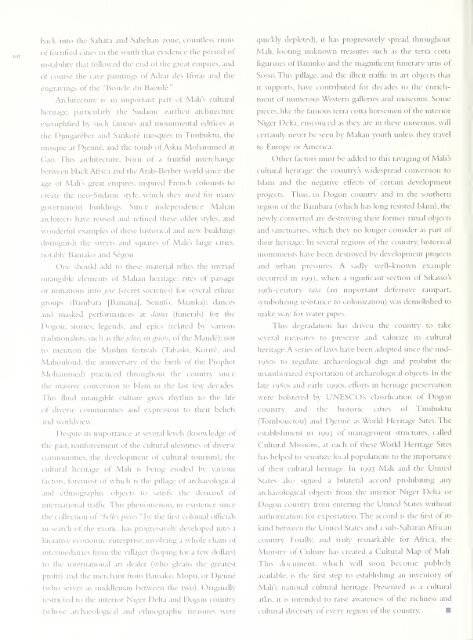SCOTLAND - Smithsonian Digital Repository - Smithsonian Institution
SCOTLAND - Smithsonian Digital Repository - Smithsonian Institution
SCOTLAND - Smithsonian Digital Repository - Smithsonian Institution
Create successful ePaper yourself
Turn your PDF publications into a flip-book with our unique Google optimized e-Paper software.
ack into the Sahara and Sahehan zone, countless nuns<br />
of fortified cities m the south that evidence the period of<br />
instabUm- that followed the end of the great empires, and<br />
of course the cave paintings of Adrar des Itoras and the<br />
engravings of the "Boucle du Baoule."<br />
Architecture is an important part of Mali's cultural<br />
heritage, particularly the Sudanic earthen architecture<br />
exemplified by such famous and monumental edifices as<br />
the Djingareber and Sankore mosques in Timbuktu, the<br />
mosque at Djenne, and the tomb of Askia Mohammed at<br />
Gao. This architecture, born of a fruitflil interchange<br />
between black Africa and the Arab-Berber world since the<br />
age of Mall's great empires, inspired French colonists to<br />
create the neo-Sudamc style, which they used for many<br />
government buildings. Since independence Malian<br />
architects have reused and refined these older styles, and<br />
wonderful examples of these historical and new buildings<br />
distinguish the streets and squares of Mah's large cities,<br />
notably Bamako and Segou.<br />
One should add to these material relics the myriad<br />
intangible elements of Malian heritage: rites ot passage<br />
or initiations into joii' (secret societies) for several ethnic<br />
groups (Bambara [Bamana], Senufo, Mianka); ciances<br />
and masked performances at ddiiui (funerals) tor the<br />
Dogon; stories, legends, and epics (related by various<br />
traditionalists, such as the jeliw, or ^riots, of the Mande);not<br />
to mention the Muslim festivals (Tabaski, Korite, and<br />
Mahouloud, the anniversary of the birth of the Prophet<br />
Mohammed) practiced throughout the countrs' since<br />
the massive conversion to Islam in the last few decades.<br />
This fluid intangible culture gives rhythm to the life<br />
of diverse conimunities and expression to their beliefs<br />
and worldview-.<br />
Despite Its importance at several levels (knowledge ot<br />
the past, reinforcement of the cultural identities ot cliverse<br />
communities, the development of cultural tourism), the<br />
cultural heritage of Mah is being eroded by various<br />
factors, foremost of which is the pillage ot archaeological<br />
and ethnographic objects to satisfy the demand ot<br />
international tratFic. This phenomenon, m existence since<br />
the coDecnon of "belles pieces" by the first colonial officials<br />
in search of the exotic, has progressively developed into a<br />
lucrative economic enterprise, involving a whole chain of<br />
intermediaries from the villager (hoping tor a tew dollars)<br />
to the international art dealer (who gleans the greatest<br />
profit) and the merchant from Bamako, Mopti, or Djenne<br />
(who serves as middleman between the two). Originally<br />
restricted to the interior Niger Delta and Dogon country<br />
(whose archaeological and ethnographic treasures were<br />
quickly depleted), it has progressively spread throughout<br />
Mall, looting unknown treasures such as the terra cotta<br />
figurines of Baninko and the magnificent fiinerary urns of<br />
Sosso. This pillage, and the illicit trafiic in art objects that<br />
it supports, have contributed for decades to the enrichment<br />
of numerous Western galleries and museums. Some<br />
pieces, hke the famous terra cotta horsemen of the interior<br />
Niger Delta, ensconced as they are m these museums, will<br />
certainly never be seen by Malian youth unless they travel<br />
to Europe or America.<br />
Other factors must be added to this ravaging of Mali's<br />
cultural heritage: the country's widespread conversion to<br />
Islam and the negative eft'ects of certain development<br />
projects. Thus, in Dogon country and in the southern<br />
region of the Bambara (which has long resisted Islam), the<br />
newly converted are destroying their former ritual objects<br />
and sanctuaries, which they no longer consider as part of<br />
their heritage. In several regions of the country, historical<br />
monuments have been destroyed by development projects<br />
and urban pressures. A sadly well-known example<br />
occurred in 1993, when a significant section of Sikasso's<br />
19th-century tatc> (an important defensive rampart,<br />
symbolizing resistance to colonization) was demolished to<br />
make way for water pipes.<br />
This degradation has driven the country to take<br />
several measures to preserve and valorize its cultural<br />
heritage.A series of laws have been adopted since the mid-<br />
19S0S to regulate archaeological digs and prohibit the<br />
unauthorized exportation of archaeological objects. In the<br />
late 1980s and early 1990s, efforts in heritage preservation<br />
were bolstered by UNESCO's classification of Dogon<br />
country and the historic cities ot Timbuktu<br />
(Tombouctou) and Djenne as World Heritage Sites. The<br />
estabhshment in 1993 of management structures, called<br />
Cultural Missions, at each of these World Heritage Sites<br />
has helped to sensitize local populations to the importance<br />
of their cultural heritage. In 1993 Mah and the United<br />
States also signed a bilateral accord prohibiting any<br />
archaeological objects from the interior Niger Delta or<br />
Dogon countrs- from entering the United States without<br />
authorization for exportation. The accord is the first of its<br />
kind beuveen the United States and a sub-Saharan Airican<br />
country. Finally, and truly remarkable for Africa, the<br />
Ministry of Culture has created a Cultural Map of Mali.<br />
This document, which will soon become publicly<br />
available, is the first step to establishing an inventory of<br />
Mall's national cultural heritage. Presented as a cultural<br />
adas, it is intended to raise awareness of the richness and<br />
cultural diversit%- of even' region ot the countrv.
















